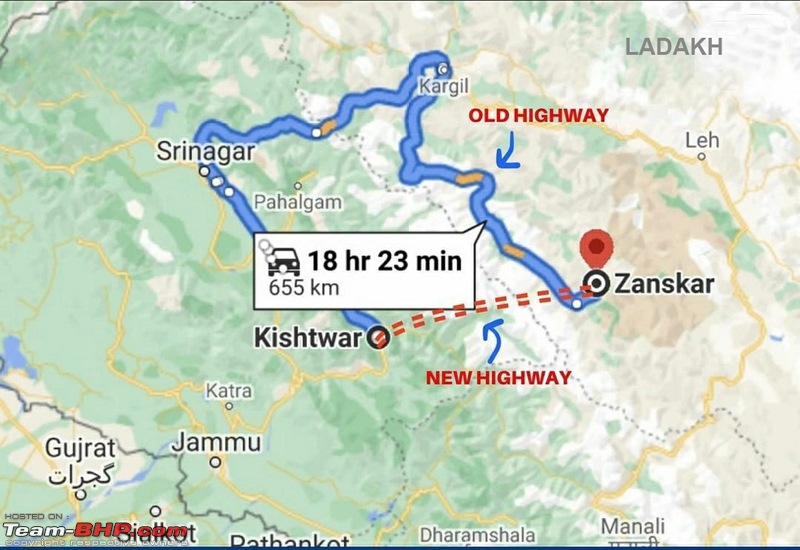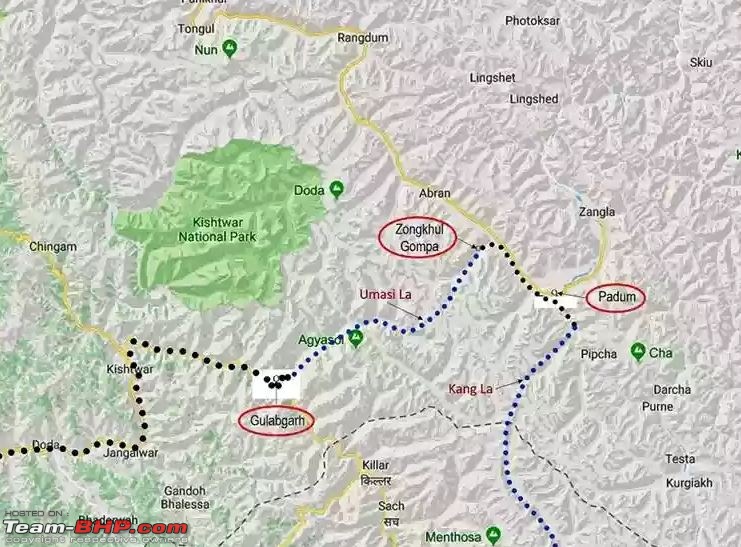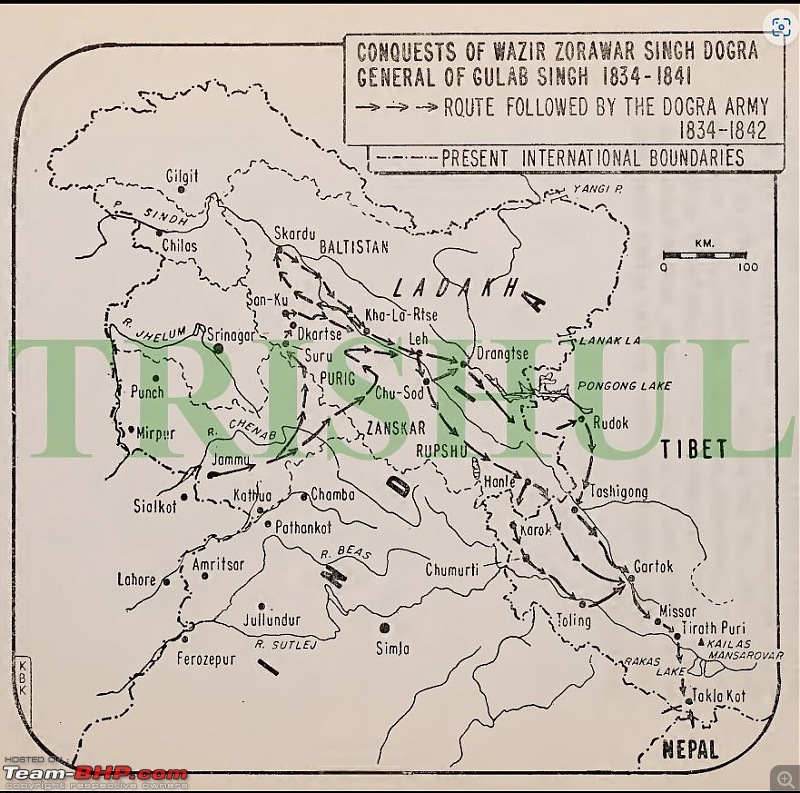| |||||||
| Search Forums |
| Advanced Search |
| Go to Page... |
 |
| Search this Thread |  7,513 views |
| | #1 | |
| Senior - BHPian Join Date: Oct 2014 Location: MH02 to MH46
Posts: 1,666
Thanked: 6,906 Times
| The new road axis to Zanskar When I say about the new axis to Zanskar, immediately what comes to your mind is the new road to Zanskar via Shinku la and the new road from Leh via Singe la. Here are the detailed links to the two routes:- Link 1: Shinku la (Zanskar and Pangi Valley | Drive to the unknown in my Endeavour 4x4) Link 2: Singe la route (Zanskar, Sham and Aryan Valley | Drive to the unknown in my Endeavour 4x4) The new proposed link is from Paddar (Kishtwar) in J&K to Padum, sub divisional headquarters of Zanskar, in Ladakh UT.  Source: https://www.dailyexcelsior.com/centr...kar-in-ladakh/ History of the routes from Kishtwar to Zanskar:- From centuries the locals use to use the trek route from Kishtwar to Zanskar via passes such as Umasi la, Hagshu la etc. Umasi la pays special significance as it was used by General Zorawar Singh to annex Ladakh and on his expedition to Tibet. Quote:
 Source: http://ai.stanford.edu/~latombe/moun...umasi-la-1.htm About Paddar / Machail area: One of the most important and shrines of Kashmir, Machail Mata also happens to be on this route. Every year lakhs of pilgrims visit the sacred shrine of Maa Chandi. The construction of the road to Machail under PMGSY is taking place at a very quick speed. More than 25 kms. of the 32 kms. road has been completed and in the future when this road from Paddar connects Padum in Zanskar, business and tourism activity along this route will grow exponentially. In the Machail valley there are 7 Buddhist villages - Haloti, Hango, Losaini, Jashairi, Gorna, Dangail and Sumcham. Culture of Buddhist people residing in these villages is akin to the people in Zanskar. There are lamas from Padum who still take care of Gompas in Paddar. Cultural interaction between these two places was happening since the 13th century, when Zanskar was under the Guge rule. Prominent Buddhist monks often visit Paddar valley. His Highness 14th Dalai Lama also visited Paddar in 2010 and blessed this land. There is also a silver idol of Maa Chandi in the temple of Machail which was installed there by the people of Zanskar centuries ago when they won the battle against the epidemic that hit there. Further reading on Paddar valley: https://mykishtwar.com/tehsil-atholi-paddar/ Blue Sapphire of Paddar:- The new alignment is along the Sapphire valley. Sapphire found in the Paddar valley is famous world-over for its unique peacock blue colour. Extraction of sapphires from Paddar began in 1880's and they achieved legendary status in the jewelery world. The gems mined during this period are valued highly and usually fetch enormous prices around the world. Located at an altitude of 4,742 metres above sea level, a 116-km stretch in the valley is estimated to have a reserve of sapphire worth ₹10,000 crore. The sapphire found here is renowned for its clarity and transparency, and are mainly used for jewelery, with a high ornamental value. The price of these “pure sapphires” easily crosses USD 100,000 a carat, making them the most expensive in their category. In 2013, a 19.88 carat cushion-shaped sapphire from Paddar, called 'Star of Kashmir', had smashed all records after it was sold for $3,483,017 (nearly ₹20 crore) at an auction in Geneva. A lot of info is available online on the Paddar Sapphire. The new alignment:- The proposal for a strategic road was done during Kargil war. A survey was also conducted during that time by two teams of Army and BRO. The then Defense ministry was also keen to have this road project cleared but due to paucity of funds, the project could not be cleared. The current new road was announced in Nov. 2021 with a survey done. MoRTH sanctioned the road. The DPR (Detailed Project Report) has been submitted. The new highway from Paddar to Zanskar is proposed via Masu - Chashoti-Machail Mata - Hagshu - Padum. There is also a proposal of a tunnel on this route under Hagshu pass, while road from Atholi (Paddar) up to Machail mata is almost ready. Military significance: - This route will be the shortest from Northern command to the northern areas and the border areas. Moreover, this internal route will be the safest to push defence supplies to Ladakh and the border areas. This new road will not only give justice to the legacy of the Napoleon of India, General Zorawar Singh, but also ease the hardships of the people in this remote region. Hope to drive on this road some day. Last edited by ruzbehxyz : 9th July 2023 at 13:50. | |
| |  (24)
Thanks (24)
Thanks
|
| The following 24 BHPians Thank ruzbehxyz for this useful post: | //M, Amit Maratha, antz.bin, Capricorn, DarthVeda, Dry Ice, FlashMustang, gauravanekar, GTO, itwasntme, Kashi053, NagaBond, nishsingh, Pr4mod, purohitanuj, Rajiv0909, rajvardhanraje, Red Liner, roy_libran, Samfromindia, sanjayrozario, Shivanshu, srh, SRISRI_90 |
| |
| | #2 |
| BHPian Join Date: May 2020 Location: Bangalore
Posts: 229
Thanked: 1,604 Times
| Re: The new road axis to Zanskar Hi Ruzbeh, Thank you so much for detailed report on this new route and sharing the history behind these routes. Another masterpiece of work from you. Your documentation on Sham and Aryan valley is so informative and hats off to you for compiling them in such a structured way. Can't wait to explore these route when it opens for civilians. |
| |  (1)
Thanks (1)
Thanks
|
| The following BHPian Thanks Kashi053 for this useful post: | ruzbehxyz |
| | #3 | |
| Senior - BHPian Join Date: Oct 2014 Location: MH02 to MH46
Posts: 1,666
Thanked: 6,906 Times
| Re: The new road axis to Zanskar Quote:
| |
| |  (1)
Thanks (1)
Thanks
|
| The following BHPian Thanks ruzbehxyz for this useful post: | Kashi053 |
| | #4 |
| Distinguished - BHPian  Join Date: Aug 2006 Location: Bangalore
Posts: 5,383
Thanked: 19,315 Times
| Re: The new road axis to Zanskar Fantastic! Love the historic research and notes behind this ancient route. And I am sure many more exist which we are unaware of! I was graced enough to visit and pay my respects to the great Zorawar Singh at his tomb in Tibet. I was told the Tibetan soldiers and their king were in such awe and respect of the general, that he was given a burial worthy of their own king. |
| |  (1)
Thanks (1)
Thanks
|
| The following BHPian Thanks Red Liner for this useful post: | ruzbehxyz |
| | #5 | |
| Senior - BHPian Join Date: Oct 2014 Location: MH02 to MH46
Posts: 1,666
Thanked: 6,906 Times
| Re: The new road axis to Zanskar Quote:
Zorawar Singh Kahluria (1784-1841) was known as the 'Napoleon of India' for his conquests in the Himalayan areas, including Ladakh, Baltistan and Tibet. General Zorawar Singh was known for being a fierce warrior, had changed the shape of Indian history. Not only was General Zorawar Singh one of the greatest Indian military commanders of all times, but he was also a strategic Commander of forces, a courageous fighter, an able administrator and planner. Rising to the ranks:- Zorawar Singh was employed by the ambitious Raja Gulab Singh ofJammu, and was placed under the commandant of the Reasi fort (Bhimgarh fort). While delivering a routine message to Gulab Singh, Zorawar told him of the financial issues occurring in the fort administration, which impressed the Raja who appointed him the commandant of Reasi. Later, seeing the honesty and sincerity of the General, the Raja appointed him Commanding officer of all forts north of Jammu. He was later made Governor of Kishtwar and was given the title of Wazir (minister). Expedition to Ladakh:- After becoming the Governor of Kishtwar, Zorawar Singh always wanted to expand the Kingdom beyond Kishtwar towards the upper reaches of the Himalayas. In 1834, the Raja of Timbus, sought Zorawar's help against the Gyalpo (King) of Ladakh. Zorawar Singh along with 5000 brave men, entered Ladakh through the Umasi la. through to Suru valley and defeated the Landlords in the Suru and Kargil areas. Later he marched towards Leh. By the spring of 1835, he defeated the large Army of the Gyalpo. Gyalpo accepted defeat but the local Chieftains again rebelled. Zorawar Singh defeated all the Chieftains and the Gyalpo was deposed to an estate. The Zorawar fort in Leh was built by him and is now a museum, which depicts the life and times of Zorawar Singh. The Expedition of Baltistan:- After defeating the Ladakhi rebels, Zorawar invaded Baltistan in the winter of 1839/40. From Kargil, Zorawar Singh and his men marched to Skardu via Chorbat pass. With great difficulty they captured the Skardu fort and dethroned the King. The Expedition of Tibet and death of Zorawar Singh:- In April 1841, Zorawar Singh marched towards Tibet. In September 1841, Zorawar Singh captured Taklakot and marched towards Lhasa. From here on Zorawar Singh and his Army went on for a pilgrimage to Kailash-Mansarovar. With the onset of winter all the passes were blocked and roads snowed in. The supplies for the Dogra army over such a long distance failed. The Tibetans regrouped and advanced to give battle. Zorawar and his men met them at the Battle of To-yo on 12 December 1841. In the exchange of fire, the general was wounded in his right shoulder, but he grabbed a sword in his left hand. Then the Tibetan horsemen charged and one of them thrust his lance in Zorawar Singh's chest. The Treaty of Chushul that brought Ladakh into India:- Untimely death of General Zoarwar Singh sent shockwaves in Jammu. What followed was a successful revenge plan. Barely 6 months after the death of General Zorawar Singh, the enemy General was killed by a combined army of Dogras and Sikhs during the battle of Chushul in the month of August 1842. The Tibetans knew that this was not the end of the war. They had anticipated that the Dogras will attack them again. The adversary thus had no option but to sign the peace treaty of Chushul. In September 1842 a treaty was signed by representatives of the Chinese and Lhasa governments on the one hand and of the Kalsa Darbar and Gulab Singh on the other which extended the Sikh, and hence Indian, frontiers to their present international boundary. The whole of Ladakh thus became a part of the Indian territories. The LAC today on the Eastern sector in Ladakh, is along these lines. But it was actually not this Treaty, but the key Treaty of Tingmosgang of 1684 between Tibet and Ladakh, which divided both places. Further reading: https://asoulwindow.com/zorawar-sing...leon-of-india/ Route followed by Zorawar Singh and his Army:-  Source: http://trishul-trident.blogspot.com/...dogra-gen.html Last edited by ruzbehxyz : 14th July 2023 at 10:36. | |
| |  (2)
Thanks (2)
Thanks
|
| The following 2 BHPians Thank ruzbehxyz for this useful post: | mpksuhas, Red Liner |
 |


